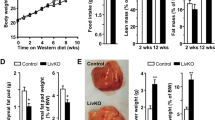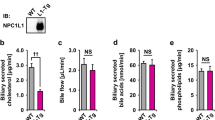Abstract
The temporal relationship of hepatic steatosis and changes in liver oxidative stress and fatty acid (FA) composition to the development of non-alcoholic steatohepatitis (NASH) remain to be clearly defined. Recently, we developed an experimental model of hepatic steatosis and NASH, the transgenic spontaneously hypertensive rat (SHR) that overexpresses a dominant positive form of the human SREBP-1a isoform in the liver. These rats are genetically predisposed to hepatic steatosis at a young age that ultimately progresses to NASH in older animals. Young transgenic SHR versus SHR controls exhibited simple hepatic steatosis which was associated with significantly increased hepatic levels of oxidative stress markers, conjugated dienes, and TBARS, with decreased levels of antioxidative enzymes and glutathione and lower concentrations of plasma α- and γ-tocopherol. Transgenic rats exhibited increased plasma levels of saturated FA, decreased levels of n−3 and n−6 polyunsaturated FA (PUFA), and increased n−6/n−3 PUFA ratios. These results are consistent with the hypothesis that excess fat accumulation in the liver in association with increased oxidative stress and disturbances in the metabolism of saturated and unsaturated fatty acids may precede and contribute to the primary pathogenesis of NASH.



Similar content being viewed by others
References
Clark JM (2006) The epidemiology of nonalcoholic fatty liver disease in adults. J Clin Gastroenterol 40(3 Suppl 1):S5–S10
Rector RS, Thyfault JP, Wei Y, Ibdah JA (2008) Non-alcoholic fatty liver disease and the metabolic syndrome: an update. World J Gastroenterol 14:185–192
Schreuder TC, Verwer BJ, van Nieuwkerk CM, Mulder CJ (2008) Nonalcoholic fatty liver disease: an overview of current insights in pathogenesis, diagnosis and treatment. World J Gastroenterol 14:2474–2486
Day CP, James OFW (1998) Steatohepatitis: a tale of two ‘‘hits’’? Gastroenterology 114:842–845
Gawrieh S, Opara EC, Koch TR (2004) Oxidative stress in nonalcoholic fatty liver disease: pathogenesis and antioxidant therapies. J Investig Med 52:506–514
Videla LA, Rodrigo R, Araya J, Poniachik J (2006) Insulin resistance and oxidative stress interdependency in non-alcoholic fatty liver disease. Trend Mol Med 12:555–558
Wanless IR, Lentz JS (1990) Fatty liver hepatitis (steatohepatitis) and obesity: an autopsy study with analysis of risk factors. Hepatology 12:1106–1110
Allard JP, Aghdassi E, Mohammed S, Raman M, Avand G, Arendt BM, Jalali P, Kandasamy T, Prayitno N, Sherman M, Guindi M, Ma DW, Heathcote JE (2008) Nutritional assessment and hepatic fatty acid composition in non-alcoholic fatty liver disease (NAFLD): a cross-sectional study. J Hepatol 48:300–307
Araya J, Rodrigo R, Videla LA, Thielemann L, Orellana M, Pettinelli P, Poniachik J (2004) Increase in long-chain polyunsaturated fatty acid n−6/n−3 ratio in relation to hepatic steatosis in patients with non-alcoholic fatty liver disease. Clin Sci (Lond) 106:635–643
Gentile CL, Pagliassotti MJ (2008) The role of fatty acids in the development and progression of nonalcoholic fatty liver disease. J Nutr Biochem 19:567–576
Qi NR, Wang J, Zidek V, Landa V, Mlejnek P, Kazdová L, Pravenec M, Kurtz TW (2005) A new transgenic rat model of hepatic steatosis and the metabolic syndrome. Hypertension 45:1004–1011
Concetti A, Massei P, Rotilio G, Brunori M, Rachmilewitz EA (1976) Superoxide dismutase in red blood cells: method of assay and enzyme content in normal subjects and in patients with beta-thalassemia (major and intermedia). J Lab Clin Med 87:1057–1064
Aebi H (1984) Catalase in vitro. Methods Enzymol 105:121–126
Kagawa Y, Uchida E, Yokota H, Yamaguchi M, Taniyama H (1998) Immunohistochemical localization of apolipoprotein B-100 (ApoB-100) and expression of glutathione peroxidase (GSH-PO) in canine atherosclerotic lesions. Vet Pathol 35:227–229
Sedlak J, Lindsay RH (1968) Estimation of total, protein-bound, and non-protein sulfhydryl groups in tissue with Elman’s reagent. Anal Biochem 25:192–205
Ward PJ, Pill GO, Hatherill JR (1985) Systemic complement activation, lung injury and products of lipid peroxidation. J Clin Invest 76:517–527
Yokode M, Kita T, Kikawa Y, Ogorochi T, Narumiya S, Kawai C (1988) Stimulated arachidonate metabolism during foam cell transformation of mouse peritoneal macrophages with oxidized low density lipoprotein. J Clin Invest 81:720–729
Catignani GL (1986) An HPLC method for the simultaneous determination of retinol and alpha-tocopherol in plasma or serum. Methods Enzymol 123:215–219
Kiyose C, Saito H, Ueda H, Igarashi O (2001) Simultaneous determination of alpha- and gamma-tocopherol and their quinones in rats plasma and tissues using reversed-phase high performance liquid chromatography. J Nutr Sci Vitaminol 47:102–107
Folch J, Lees M, Sloane Stanley GH (1957) A simple method for the isolation and purification of total lipides from animal tissues. J Biol Chem 226:497–509
Bahcecioglu IH, Yalniz M, IIhau N, Ataseven H, Ozercan IH (2005) Levels of serum vitamin A, alpha-tocopherol and malondialdehyde in patients with non-alcoholic steatohepatitis: relationship with histopathologic severity. Int J Clin Pract 59:318–323
Alwayn IP, Gura K, Nose V, Zausche B, Javid P, Garza J, Verbesey J, Voss S, Ollero M, Andersson C, Bistrian B, Folkman J, Puder M (2005) Omega-3 fatty acid supplementation prevents hepatic steatosis in a murine model of nonalcoholic fatty liver disease. Pediatr Res 57:445–452
Calder PC (2007) Immunomodulation by omega-3 fatty acids. Prostaglandins Leukot Essent Fatty Acids 77:327–335
Nakamura MT, Cho HP, Clarke SD (2000) Regulation of hepatic Δ-6 desaturase expression and its role in the polyunsaturated fatty acid inhibition of fatty acid synthase gene expression in mice. J Nutr 130:1561–1565
Ghafoorunissa G, Ibrahim A, Rajkumar L, Acharya V (2005) Dietary (n−3) long chain polyunsaturated fatty acids prevent sucrose-induced insulin resistance in rats. J Nutr 135:2634–2638
Griffin MD, Sanders TA, Davies IG, Morgan LM, Millward DJ, Lewis F, Slaughter S, Cooper JA, Miller GJ, Griffin BA (2006) Effects of altering the ratio of dietary n−6 to n−3 fatty acids on insulin sensitivity, lipoprotein size, and postprandial lipemia in men and postmenopausal women aged 45–70 y: the OPTILIP Study. Am J Clin Nutr 84:1290–1298
Sjögren P, Sierra-Johnson J, Gertow K, Rosell M, Vessby B, de Faire U, Hamsten A, Hellenius ML, Fisher RM (2008) Fatty acid desaturases in human adipose tissue: relationships between gene expression, desaturation indexes and insulin resistance. Diabetologia 51:328–335
Comte C, Bellenger S, Bellenger J, Tessier C, Poisson JP, Narce M (2004) Effects of streptozotocin and dietary fructose on delta-6 desaturation in spontaneously hypertensive rat liver. Biochimie 86:799–806
Brenner RR, Rimoldi OJ, Lombardo YB, González MS, Bernasconi AM, Chicco A, Basabe JC (2003) Desaturase activities in rat model of insulin resistance induced by a sucrose-rich diet. Lipids 38:733–742
Gasperikova D, Demcakova E, Ukropec J, Klimes I, Sebokova E (2002) Insulin resistance in the hereditary hypertriglyceridemic rat is associated with an impairment of delta-6 desaturase expression in liver. Ann N Y Acad Sci 967:446–453
Vessby B, Gustafsson IB, Tengblad S, Boberg M, Andersson A (2002) Desaturation and elongation of fatty acids and insulin action. Ann N Y Acad Sci 967:183–195
Perlemuter G, Davit-Spraul A, Cosson C, Conti M, Bigorgne A, Paradis V, Corre MP, Prat L, Kuoch V, Basdevant A, Pelletier G, Oppert JM, Buffet C (2005) Increase in liver antioxidant enzyme activities in non-alcoholic fatty liver disease. Liver Int 25:946–953
Videla LA, Rodrigo R, Orellana M, Fernandez V, Tapia G, Quiñones L, Varela N, Contreras J, Lazarte R, Csendes A, Rojas J, Maluenda F, Burdiles P, Diaz JC, Smok G, Thielemann L, Poniachik J (2004) Oxidative stress-related parameters in the liver of non-alcoholic fatty liver disease patients. Clin Sci (Lond) 106:261–268
Koruk M, Taysi S, Savas MC (2004) Oxidative stress and enzymatic antioxidant status in patients with nonalcoholic steatohepatitis. Ann Clin Lab Sci 34:57–62
Nobili V, Pastore A, Gaeta LM, Tozzi G, Comparcola D, Sartorelli MR, Marcellini M, Bertini E, Piemonte F (2005) Glutathione metabolism and antioxidant enzymes in patients affected by nonalcoholic steatohepatitis. Clin Chim Acta 355:105–111
Elizondo A, Araya J, Rodrigo R, Poniachik J, Csendes A, Maluenda F, Díaz JC, Signorini C, Sgherri C, Comporti M, Videla LA (2007) Polyunsaturated fatty acid pattern in liver and erythrocyte phospholipids from obese patients. Obesity (Silver Spring) 15:24–31
Acknowledgments
This work was supported by National Institutes of Health grants HL35018, HL56028, and HL63709 (T.W.K) and by grant IAA500110604 from the Czech Academy of Sciences, grants NR9387 and NR9359 from the Ministry of Health of the Czech Republic and the European Commission within the Sixth Framework Programme through the Integrated Project EURATools (contract no. LSHG-CT-2005-019015) (M.P.). M.P. is an international research scholar of the Howard Hughes Medical Institute.
Author information
Authors and Affiliations
Corresponding author
Rights and permissions
About this article
Cite this article
Malínská, H., Oliyarnyk, O., Hubová, M. et al. Increased liver oxidative stress and altered PUFA metabolism precede development of non-alcoholic steatohepatitis in SREBP-1a transgenic spontaneously hypertensive rats with genetic predisposition to hepatic steatosis. Mol Cell Biochem 335, 119–125 (2010). https://doi.org/10.1007/s11010-009-0248-5
Received:
Accepted:
Published:
Issue Date:
DOI: https://doi.org/10.1007/s11010-009-0248-5




